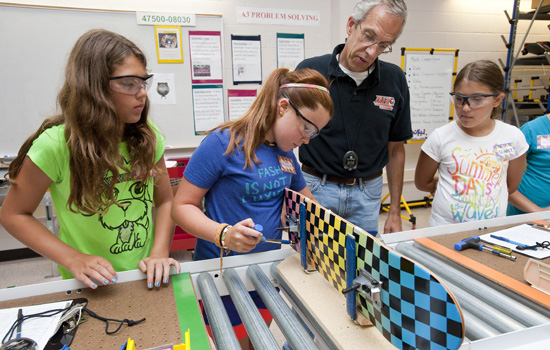Engineering team designs STEM activities for kids
Age-appropriate STEM activities feature real-world engineering problems and solutions
WE@RIT
John Kaemmerlen works with youngsters in the Toyota Production Systems Lab. He and members of the REMS team designed a series of online, age-appropriate activities for the K-12 community similar to those done onsite at the lab.
What teacher has not heard students challenge, “Why do I need math? Why am I learning this? I’m never going to use it.”
To help teachers answer these questions, an engineering team from Rochester Institute of Technology developed the REMS Program—Relevant Education in Math and Science—a series of online STEM activities that can provide a way to associate math and science with solving engineering problems.
Designed for elementary, middle and high school students, the program is built around three real-world scenarios: preserving competitive manufacturing, developing and delivering efficient health care services and distributing products and services across the world. The online activities consist of overview videos, teacher lesson plans, student worksheets and several process simulations. The team is finalizing testing and the full set of activities can be reviewed online.
“We wanted to pick activities that would be fun and engaging for the kids. Each one is then adapted for different grade levels, and each of the lesson plans is adapted to serve the needs of those students, asking different questions and getting different outcomes based on their knowledge,” said Jacquie Mozrall, principal investigator for the project.
One of the activities for example, a skateboard assembly, uses simple math to demonstrate “cycle time”—the time it takes to assemble a product with individual team members at different workstations providing parts. Timing the activity and adjusting tasks allows students to use concepts such as calculating averages, modeling and using percentages, said Tina Bonfiglio, REMS K-12 educator, consultant and outreach liaison.
“There are lots of efforts out there to introduce students to ‘what is engineering?’ One of our goals is making the linkage between what the students are doing in middle school and high school math and science classes to how you have to actually use these skills to solve engineering problems,” she said.
Other activities include modules on ergonomic design, meal picking and assembly, and household container recycling.
In 2010, the REMS team received a grant from the Toyota USA Foundation to develop the activities and to provide teachers with additional math and science resources. All of the modules have been evaluated by area students and educators early in the development process, and tested in the engineering college’s Toyota Production Systems Laboratory, a multipurpose facility for teaching and research. The lab features a reconfigurable production line and distribution facility. It is widely used for undergraduate and graduate courses in the engineering college and is also used to support outreach activities conducted by the college’s Women in Engineering Program.
Members of the REMS team are Mozrall; Bonfiglio; industrial and systems engineering faculty John Kaemmerlen, Matthew Marshall and Michael Kuhl; and Jodi Carville, director, Women in Engineering. Students from the college’s industrial and systems engineering department also assisted in presenting and testing the online and onsite programming. Over the next month the team will complete testing on the final modules. The entire package will be available by the end of August.
“These have been designed with educators’ input,” Mozrall added. “There is a push to add more STEM activities in classrooms, and this effort provides a ready-made package that educators, community leaders and organizations can go online and use, wherever they happen to be.”
More information about the program can be found on the program’s website.
Related article:
Toyota Foundation awards grant to RIT’s engineering college of K-12 STEM program














